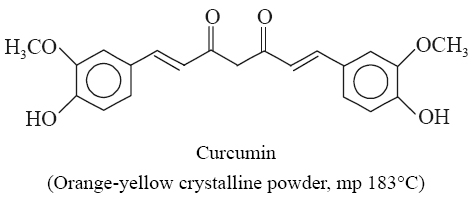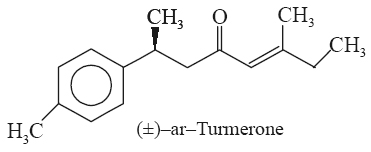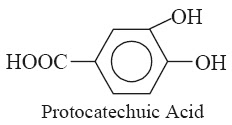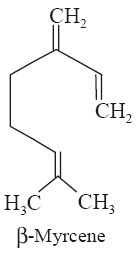2.9 Oleo-Gum-Resins
The oleo-gum-resins
are the naturally occurring mixture of resin, gum, volatile oil, and mostly
small quantities of other substances.
There are some potent oleo-gum-resins
which exhibit remarkable medicinal values. A few such drugs shall be
discussed briefly here under: Asafoetida; Ammoniacum; Turmeric; Myrrh;
Indian Bdellium etc.
1. Asafoetida
Synonyms Asafetida; Asant; Devil's dung; Food of the Gods; Gum Asafoetida.
Biological Sources Asafoetida the oleo-gum-resin is obtained as an exudation of the decapitated rhizome on roots of Ferula assafoetida L.; Ferula foetida Regel, and some other species of Ferula, belonging to the nature order Umbelliferae.
Preparation Asafoetida is generally present as a milky liquid in the large schizogenous ducts and lysigenous cavities. However, these ducts and cavities are located more intensively in the cortex region of the stem and root. The drug is obtaining chiefly from the stem.
The fully grown plants are usually cut down to the crown region during the spring. The exposed surface is protected by a dome-like covering made up of twigs and leaves. After about a month, the hardened resinous substance is collected by scrapping. Likewise, the stems are also cut off and thereby additional collections of asafoetida are made frequently at an interval of 10 days unless and until the exudation ceases to ooze. Furthermore, it is also collected from the root by exposing its crown and excising the stem. The oleo-gum-resin exudes from the cut surface of the root and the former is collected soonafter it gets dried. Thus, the entire collection of asafoetida from the various portions of the plant are mixed together and dried in the sun.
Characteristic Features The drug occurs normally as soft mass or irregular lumps or ‘tears’ or agglomeration of tears. The tears are brittle and tough. Asafoetida has a strong, alliaceous, persistent garlic-like odour and having a bitter acrid taste. This oleo-gum-resin when triturated with water it gives a milky emulsion.
Chemical Constituents Asafoetida contains volatile oil (8-16°C) gum (25%) and resin (40-60%).
The volatile oil essentially consists of some organic sulphides solely responsible for attributing the characteristic garlic-like odour. The resin cousists of notannol, asaresinotannol i.e., the resin alcohols, which are present partially in the free state and partially in the combined form with ferulic acid. It also contains umbellic acid and umbelliferone; the latter is found combined with ferulic acid, but it gets generated on being treated with dilute HCl.
There are three sulphur-compounds that have been isolated from the asafoctida resin, namely:
(a) 1-Methylpropyl-1-propenyl disulphide,
(b) 1-(Methylthio) propyl-1-propenyl disulphide, and
(c) 1-Methylpropyl-3-(methylthio)-2- propenyl disulphide.
Interestingly, the latter two (i.e., ‘b’ and ‘c’) have pesticidal properties.
Chemical Tests
1. It forms an instant milky-white emulsion when triturated with water owing to the presence of gum.
2. The freshly fractured surface when treated with a drop of sulphuric acid (conc.), it gives rise to a reddish-brown colour which on being washed with water changes to violet colouration.
3. Likewise, when the freshly fractured surface is treated with nitric acid (50%), it produces a green colour readily.
4. Boil 1 g asafoetida powder with HCl (50%), filter and make the filtrate strongly alkaline with NH4OH (conc.), it gives a blue fluorescence. It is also known as the Umbelliferone Test.
Uses
1. It is abundantly used in India and Iran as a common condiment and flavouring agent in food products.
2. It is also an important ingredient in Worcestershire Sauce.
3. It is used as a repellant [2% (w/v) suspension] against dogs, cats, deer, rabbits etc.
4. It is used seldomly as an antispasmodic, carminative, expedorant and laxative.
5. It is still employed in veterinary externally to prevent bandage chewing by dogs.
6. It is also used as a powerful nerving stimulant especially in nervous disorders related to hysteria.
2. Ammoniacum
Synonym Gum ammoniac.
Biological Source It is a oleo-gum-resin exuded from the flowering and fruiting stem of Dorema ammoniacum, D. Don. and probably other species belonging to family: Umbelliferae.
Preparation The exudation of the milky-secretions obtained in the form droplets is usually caused by the beetles that puncture the fruiting stem of D. ammoniacum. While quite a few of these milkydroplets get hardened on the stem itself, and the rest falls on the ground. The solidified oleo-gumresins are scrapped from the stem with a plant-knife and also collected from the droppings on the ground.
Characteristic Features The drug has an irregular, rounded tears, that are yellowish or browish outside and whitish from within; these are generally brittle when cold, but get softened on warming.
It is also found, in the form of mass i.e., agglomeration of small droplets. The mass is found to be darker in colour and less homogeneous.
It has a peculiar odour, slightly sweetish, bitter and somewhat acrid taste. The physical
characteristics are: mp 45-55°C and d 1.207. Its acid number varies between 60-80, whereas the saponification number ranges between 97-114. It is partly soluble in water, ethanol, ether, vineger, or alkaline solution. It readily forms an emulsion with water.
Chemical Composition Ammoniacum-the oleo-gum-resin consists of volatile oil (0.1-1.0%), resin (65-70%), gum (20%), moisture (2-12%), insoluble residue (3.5%) and ash (1%). Ammoresinol, a phenolic substance is the main constituent of the resin, which is a colourless crystal, mp 110°C. It also contains traces of salicylic acid.
Chemical Tests
1. Ammoniacum when triturated with water, it forms a white emulsion.
2. A portion of the above emulsion when treated with a solution of chlorinated soda gives a deep orange-red colouration.
3. A portion of the emulsion on being treated with a potash solution yields a yellow colour.
4. A portion of the emulsion when treated with a 0.1% (w/v) solution of FeCl3, it gives an instant violet colouration due to the presence of traces of salicylic acid.
Uses
1. It is an important ingredient of porcelain cements.
2. It is a stimulant, and secreted by the bronchial mucous surface, thereby disinfecting the secretions.
3. It is used in plaster-of-paris (POP) plasters as a stimulant to the skin.
4. It is also used as a disinfectant expectorant in chronic bronchitis amalgamated with excessive discharge.
3. Turmeric
Synonyms Curcuma; Indian Saffron; Tumeric.
Biological Source Turmeric is obtained from the rhizome of Curcuma longa Linn. (Curcuma domestica Valeton) belonging to the natural order Zingiberaceae.
Preparation The plant is normally harvested after 9-10 months when the lower leaves start becoming yellow. The rhizome is carefully dug out from the soil with a blunt knife without damaging it. The fibrous roots are discarded. The raw green turmeric is cured and processed by boiling the rhizomes with water for a duration ranging between 12-14 hours. Subsequently, the cooked rhizomes are dried in the sun for 5-7 days. Cooking process helps in achieving two objects, namely:
(a) Gelatinization of starch, and
(b) Yellow colouration, due to curcumin, spreads over the entire rhizome.
Characteristic Features Turmeric has an aromatic pepper-like but somewhat bitter taste. It gives curry dishes their characteristic yellowish colouration.
Chemical Constituents It contains volatile oil (5-6%), resin and substantial quantity of zingiberaceous starch grains. The marked and pronounced yellow colour in turmeric is due to the presence of curcuminoids which essentially contains curcumin as given below:
The curcuma oil* obtained from turmeric contains (±)-ar-turmerone as given below:
The volatile oil contains a host of chemical substances, such as: d-α-phellandene, d-sabinene, cineol, borneol, zingiberene, and sesquiterpenes.
Turmeric also contains some other chemical constituents, namely: p,p-dihydroxy dicinnamoylmethane; p-α-dimethy benzyl alcohol; p-hydroxy-cinnamoylferuloylmethane; 1-methyl-4-acetyl-1-cyclohexene; and caprylic acid.
Chemical Tests
1. Turmeric powder when triturated with alcohol it imparts a deep yellow colour to the resulting solution.
2. The powdered drug when treated with sulphuric acid it imparts a crimson colour.
3. The aqueous solution of turmeric with boric acid gives rise to a reddish-brown colouration which on subsequent addition of dilute alkali changes instantly to greenish-blue.
4. Turmeric powder when reacted with acetic anhydride and a few drops of concentrated sulphuric acid (36 N), it readily gives a violet colouration. Interestingly, the resulting solution when observed under the ultraviolet light (preferably in a uv-chamber), it exhibits an intense red fluorescence, which is due to the presence of Curcumin.
Uses
1. It is extensively used across the globe as a condiment as curry powder.
2. It is employed as a colouring agent for ointments.
3. It is used medicinally as a tonic, as a blood purifier, as an anthelmintic and finally as an aid to digestion.
4. It is used extennally in the form of a facial cream to improve complexion and get rid of pimples.
5. A small quantity of turmeric when boiled with milk and sugar; it helps to cure common cold and cough symptoms.
-------------------------------------------------
* H. Rupe et. al. Helv. Chim. Acta, 17, 372 (1934).
4. Myrrh
Synonyms Gum Myrrh, Myrrha.
Biological Source Myrrh is an oleo-gum-oresin obtained from the stem and branches of Commiphora obyssinica (Berg) Engler or from other species of Commiphora belonging to family Burseraceae.
Preparation The plants usually exude yellow coloured resin after proper incisions are made in the bark of a tree. It gradually hardens and becomes dark or reddish-brown in appearance. The mass is collected by the native tribals of Somalia for trading.
Characteristic Features Myrrh normally occurs either in the form of isolated irregular, rounded tears of 2.5 cm in diameter or as masses duly formed by the agglomeration of these tears. The tears are dull, rough and reddish-brown in appearance. It has a strong aromatic odour and possesses an acrid, bitter taste.
Chemical Constituents Myrrh contains volatile oil (7-17%), resin (20-25%), gum (57-61%), and bitter principle (3 to 4%). The volatile oil consists of eugenol, m-cresol and cuminaldehyde.
The resin is found to consist of a mixture of α-, β-, and γ-commiphoric acids (resin acids). Besides, it also contains two phenolic resins α- and β-heerabomyrrholic acids which are ether insoluble.
The oleo-gum-resin yields alcohol-soluble extract not less than 30%. It also contains phenolic compound such as: pyrocatechin and protocatechuic acid. The crude alcohol-insoluble fraction i.e., ‘gum, comprises of protein (18%) and carbohydrate (64%) made up of arabinose, galactose and glucuronic acid. However, the gum is found to be associated with an oxidase enzyme.
Chemical Tests
1. Myrrh when triturated with water produces an yellow-emulsion.
2. When myrrh (0.1 g) is triturated with 0.5 g of pure washed sand (SiO2) in the presence of ether, filtered and evaporated on an electric water-bath, it forms a thin film of violet colour on being exposed to bromine vapours in a closed dessicator.
Uses
1. It is used chiefly in perfumes and incense.
2. It is frequently employed as an antiseptic and stimulant.
3. Myrrh acts as an astringent to the mucous membrane and hence it find its application in oral hygiene formulations, such as: gargles, mouth-washes.
4. It is also used as a carminative.
5. Indian Bdellium
Synonym Scented bdellium.
Biological Sources Indian bdellium is the oleo-gum-resin obtained from the bark of the naturally occurring plant Commiphora mukul Engler., Balsamodendron mukul Hook. ex. Stocks., and Commiphora weightii (Arn) Bhand, belonging to family: Burseraceae.
Preparation The oleo-gum-resin Indian bdellium is obtained by the incision made on the bark and the exudates are collected. Each fully grown plant produces about 0.5 to 1 kg of the product which is normally collected from January through March every year.
Characteristic Features The oleo-gum-resin from Indian bdellium has a brown to pale yellow or sometimes dull green colour. It has an agreeable balsamic and aromatic odour with a typical bitter taste. The drug is usually obtained as irregular mass, rounded or agglomerated cluster of tears. The tears are found to be transparent, having a waxy surface and quite brittle in nature. It is sticky in touch and has a fractured surface. It is partially alcohol soluble; but when triturated with water it usually gives rise to a white emulsion.
Chemical Constituents This oleo-gum-resin mostly comprises of resin (60%), gum (30%), volatile oil (1–1.5%) moisture (5%) and foreign organic substances (3-4%). The volatile oil fraction contains various terpenes, such as: β-murcene, dimyrcene, polymyrcene, caryophyllene and isocaryophyllene (Section 2.9.2).
Source:Pharmacognosy And Pharmacobiotechnology By Ashutosh Kar







0 Comment:
Post a Comment